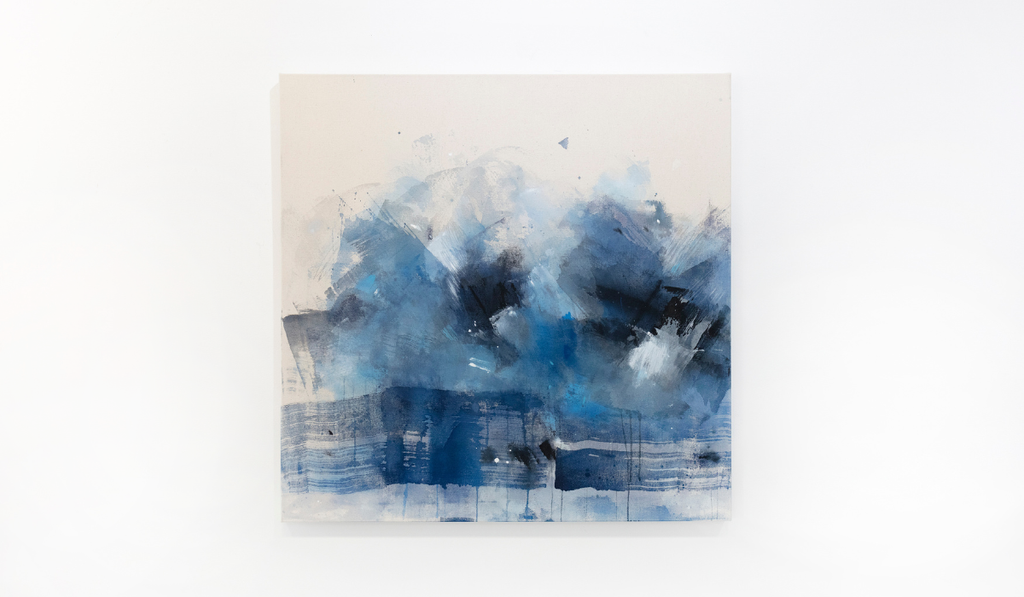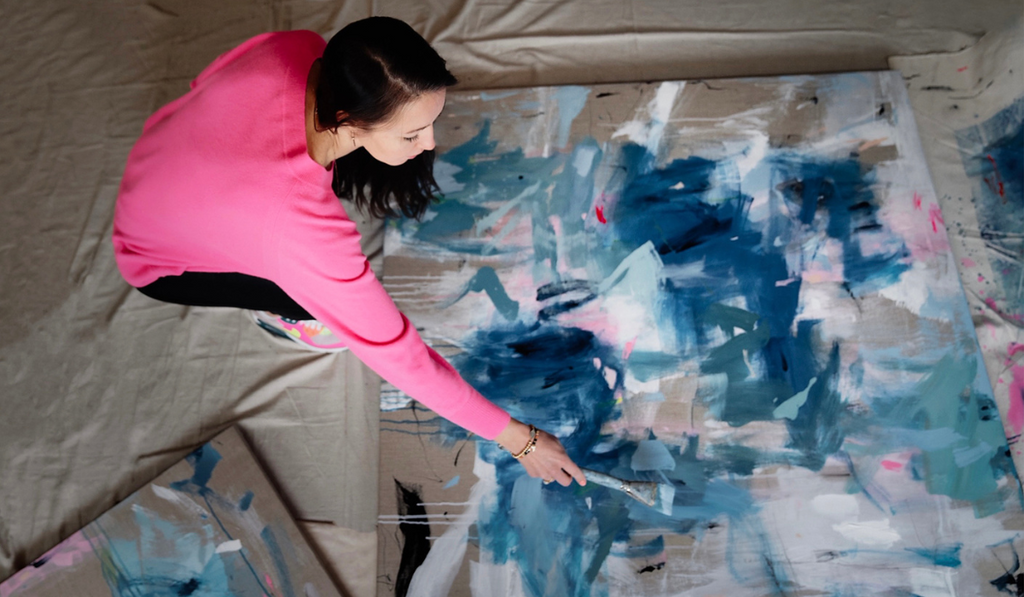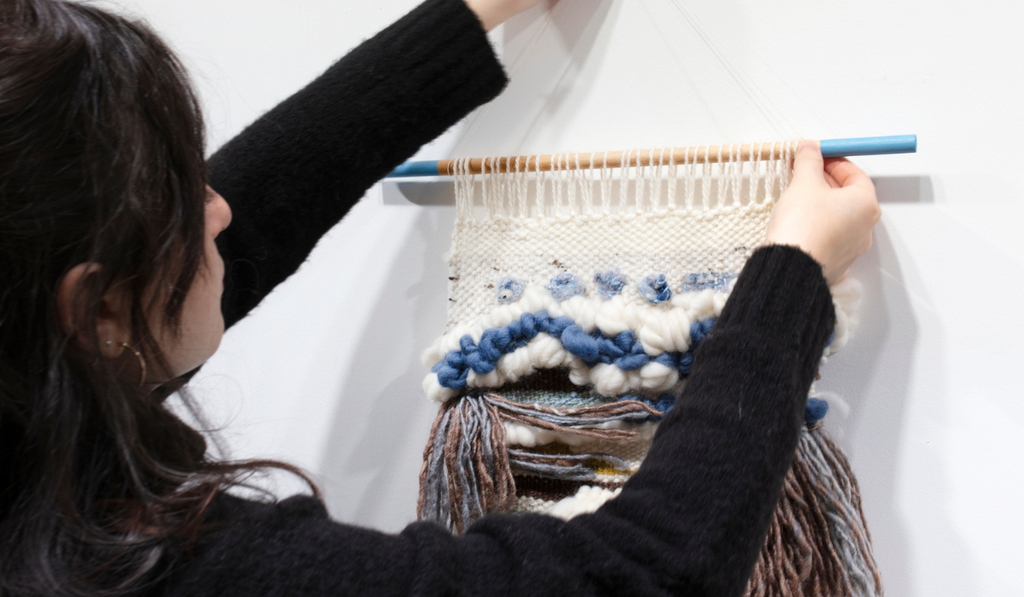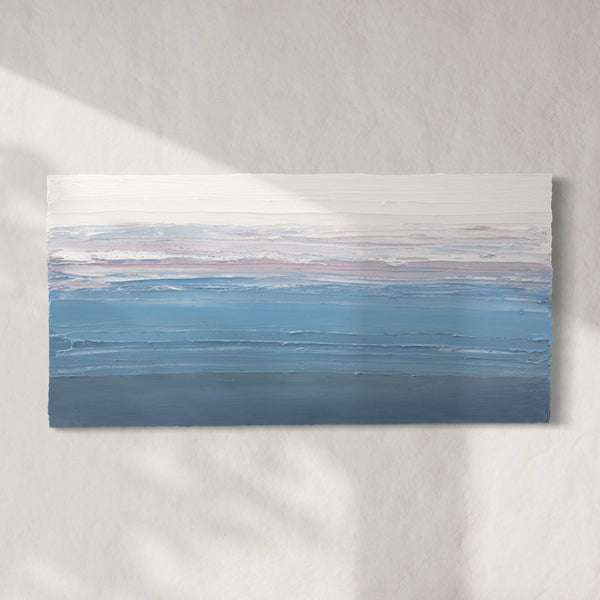We've said it before and we'll say it again: navigating the art world can be tricky, particularly online. So what do all those words mean that you keep seeing - "acrylic," "impasto," "salon," "plein air?" That last one's not even in English! So we're breaking down all those confusing, artsy terms in a simple glossary. From major art movements, to painting techniques, to the different types of glazes you might see on pottery pieces, we've got the run-down so that your art exploration is less confused, more confident.
Abstract
A style of artwork that does not represent the real world (or attempt to), but rather creates a visual through the use of shapes, color, form, texture, line, and more. While some work is purely abstract, some more naturalistic pieces may be "abstracted."
Abstract Expressionism
A movement in American painting which took place in the 1940s and 1950s, and emphasized the spontaneity and emotiveness of creative expression. Key players in the Abstract Expressionist movement were Jackson Pollack who is known for his drip technique referred to as "action painting," Mark Rothko (a color field painter - see below), and Willem de Kooning.
 A painting by Kelly Rossetti features wide, sweeping strokes which are spontaneous and intuitive, in the spirit of the Abstract Expressionist movement.
A painting by Kelly Rossetti features wide, sweeping strokes which are spontaneous and intuitive, in the spirit of the Abstract Expressionist movement.
Acrylic (Paint)
Acrylic paint is a water-based paint made of pigment suspended in acrylic polymer emulsion. Acrylic paint can be diluted with water or thickened using pastes or gels, which allows the artist to manipulate the aesthetic. If a significant amount of water to acrylic paint, it achieves a "wash" consistency - which resembles watercolor when applied. Adding little-to-no water results in a thicker, highly saturated paint. Acrylic paint is known for drying very quickly.
Acrylic (Photography Mount)
An acrylic print is made by printing a photograph on a high-quality photo paper, which is then pressure bonded to two sheets of acrylic, usually with a float mount on the back. Because of the float mount, no bolts are visible in the corners.
Plexiglass is another term used to describe the same mount and finish as an Acrylic print. Acrylic is an abbreviation for the chemical used to create plexiglass, and plexiglass has become the generic term for this type of plastic, which is also referred to by its trademarked name, Plexiglas.
Archival
Archival can refer to several different materials including inks, canvas, or paper, and signifies the high quality nature of the material to last for a long period of time (in an archive).
Canvas
A strong cloth material used for painting (and other uses) which is typically made from cotton or hemp.
Collage
A medium by which the artist combines multiple materials such as paper, photographs, fabric, or paint together in a single 2-dimensional piece.
Color Field
A type of painting style established by American Abstract Expressionists like Mark Rothko in the 1950s and 1960s, who applied large expanses of usually a single flat color to canvases.
Contemporary
Art which is produced by artists who are currently living. Contemporary design similarly reflects the styles of present day but is often associated with clean lines, neutral colors, and natural materials.
Ceramic
A pottery medium which is made from naturally-occurring raw materials like clay, earthen materials, and water, forming and then firing them at high temperatures. There are varying types of ceramics, like porcelain, for example - see more about this type of ceramic below.
Crystalline Glaze
Crystalline glazes are special ceramic glazes in which zinc-silicate crystals grow inside the glaze while it is still very hot. The crystals begin as microscopic seeds in the glaze, which form in random numbers and locations. When the kiln is cooled to the proper temperature, crystals start to grow. In order for crystals to grow, the glaze must be very fluid. Much of the glaze runs off the vessel during the firing into a catch basin and pedestal that are specially made for each piece. After the firing, the piece is carefully separated from the pedestal with a hammer and chisel and the base is ground smooth.
 A blue ceramic vase by Jon Puzzuoli features white "crystals" formed over it's surface.
A blue ceramic vase by Jon Puzzuoli features white "crystals" formed over it's surface.
Diptych
Two 2-dimensional artworks made in conjunction with one another, typically with the intent of hanging side-by-side.
Encaustic
Encaustic literally means to 'burn in,' from the Greek word 'enkaustikos.' This name comes from the fact that in encaustic painting, each layer must be fused with heat to the layer beneath it. The base medium which is used for encaustic painting is primarily made from beeswax. The wax is mixed with damar resin which is crystallized sap from fir trees. The damar resin provides hardness while the wax provides luminosity. Encaustic art can be made with only this clear combination or mixed with high quality pigments.
Fiber (Arts)
A form of art which uses natural or synthetic textiles or materials such as fabric or yarn, and focuses on the process of production as part of it's own significance. Materials in fiber arts could be quilted, embroidered, woven, knitted, and more.
Figurative
Any artwork which has a clear reference to the real world, with a particular emphasis on the human figure or form.
Form
The Tate provides a synopsis of the two meanings of form in the context of art: "...It can refer to the overall form taken by the work – its physical nature; or within a work of art it can refer to the element of shape among the various elements that make up a work."
Gallery Wrap Canvas
Canvas which is stretched over wood stretcher bars so that it wraps around to the back of the wood stretcher. Some artists will choose to add a floater frame to a gallery wrapped canvas, while others will choose to paint the sides of the canvas where it is wrapped over the stretchers.
Geometric Abstraction
A type of abstract artwork which incorporates geometric elements like straight lines, shapes, and other similar forms.
Gesso
Gesso is a white paint mixture which incudes a binder mixed with chalk, gypsum, pigment, or any combination of these. It is typically painted as a first coat on canvas or paper, acting as a highly absorbent primer for paintings, particularly oil paintings where the paint has an oil base.
Gestural
A term used to describe the technique of applying paint to a canvas in wide, sweeping strokes. These are often more large, and loose than what would be described as "painterly."
 Artist Kelly Rossetti paints gesturally in her Connecticut studio.
Artist Kelly Rossetti paints gesturally in her Connecticut studio.
Gouache
Pronounced "gwahsh," gouache is a watercolor paint which has an additional binder added to it, so that it loses the translucency of typical watercolor paint, giving it a smooth, mat finish.
Gold Luster
Gold luster is made from particles of real gold in a liquid medium. It is typically applied over top of a glaze-fired pottery piece and then fired again.
Impasto
A painting technique whereby thick layers of paint are applied to the canvas, creating visible texture which stands off on the surface of the piece. This is achieved with a paint brush or, very often, a palette knife.
 Artist Teodora Guererra applies thick layers of layers paint to create texture which stands off the canvas.
Artist Teodora Guererra applies thick layers of layers paint to create texture which stands off the canvas.
Impressionism
Beginning in the early 1860's, the Impressionist movement was marked by artists' move outside the studio, aiming to capture an impression of everyday life through the use of light, color, and quick, loose brush strokes. Notable artists who were part of the Impressionist movement were Claude Monet, Auguste Renoir, Edgar Degas, Mary Cassatt, and more.
Illustration
Artwork which aims to interpret, explain, exemplify, or capture an idea or story.
Landscape
Art which depicts the natural landscape including trees, rivers, bodies of water, mountains, and more.
Leaf (Gold, Silver, Copper)
Gold leaf is an extremely light, thin sheet of gold which is achieved through the process of "goldbeating" (hammering it into sheets). Metal leaf refers to a metallic sheet that does not have real gold in it. In order to apply gold leaf, the artist will first layer an adhesive over the surface of a painting, and lay the gold leaf sheet over top of it. After allowing for drying time, the artist will use a large dry brush to lightly sweep away the flecks of gold or metal leaf which were not adhered, leaving only the adhered metallic material behind.
 An encaustic painting (see term above) by Linda Bigness incorporates silver leaf to add to the natural texture of the wax and resin-based medium.
An encaustic painting (see term above) by Linda Bigness incorporates silver leaf to add to the natural texture of the wax and resin-based medium.
Metal Sublimation (Photography Mount)
While acrylic prints are printed on paper and then adhered to an acrylic sheet, metal prints differ in that they go through a process called dye sublimation, which allows the metal to absorb the ink directly. Because of this process, which infuses the color into the coating of the metal rather than placing it on the surface, a metal print is highly durable, scratch-resistant, and won't fade. Photography that works best on metal are those that are highly detailed, and that feature bright colors. Like acrylic, they tend to have a modern aesthetic.
Mid-Century Modern
A type of design aesthetic which was prevalent in the 1950s and 1960s. It paired organic and geometric shapes and lines, and earth tones along with bright colors, celebrating the decorative aspects of each element of a space.
Minimalism
Art which is typically highly abstract, simple in composition or form, and does not attempt to imitate another object or real life. Rather, it explores the most simplified, purified essence of an idea or concept.

Minimalist painter Tony Iadicicco uses only lines and soft, blended color to simplify an idea down to it's most pure essence.
Mixed Media
Mixed media is the incorporation of more than one medium in a painting. Some artists will list individual media, or refer to the final piece's medium as "mixed media."
Modern Art
Artwork which was created in the late 19th century and throughout the 20th century, most of which was a response to wide-sweeping technological advances of the time period. Artists depicted their personal experiences and interpretations of a quickly-evolving social and political landscape.
 Phoenix Nest by modern artist Stanley Bate is reflective of style of the 1960s and 1970s during which this abstract painting was created.
Phoenix Nest by modern artist Stanley Bate is reflective of style of the 1960s and 1970s during which this abstract painting was created.
Naturalistic
Art which aims to depict the natural world in a style which emulates the real object or scene.
Oil (Paint)
A type of paint consisting of particles of pigment in drying oil (most often a vegetable oil). It dries very slowly, which means that it requires long periods of drying time between layers, or allows for mixing colors directly on the canvas. Unlike acrylic and watercolor paints which have water bases, oil paint has an oil base. Oil paint has been used for centuries, but became very popular in Europe in the 15th century.
Painterly
A term which refers to loose, visible brush strokes over the surface of a painting.
Panel
Panel, sometimes referred to as "board" is a painting surface which is a wood alternative to canvas or paper. Some artists will paint directly on panel, while some will wrap canvas around a panel and then frame it.
Plein Air
A French term coined during the Impressionist movement when pre-mixed tubes of paint became more widely available, painting en plein air refers to the practice of an artist physically painting outdoors.
 New Hampshire-based artist Bri Custer paints her landscapes "en plein air," most often on location throughout New England.
New Hampshire-based artist Bri Custer paints her landscapes "en plein air," most often on location throughout New England.
Porcelain
A type of ceramic which is made from kaolin clay and other natural materials, and fired at high temperatures for long-lasting durability.
Print (Open and Limited)
A reproduction or print is created from a professional, high-quality digital capture of an original artwork. Limited Edition prints are high-quality reproductions of original fine artwork that are made in limited quantities. This means that there will only that number of prints in circulation, and are therefore considered to be higher in value. Open Edition prints are also reproductions of an original fine artwork, but there are no limits to the number of prints that may be created.
Raku
Raku is a type of low-firing pottery process that was inspired by traditional Japanese raku firing. Western-style raku usually involves removing pottery from the kiln while at bright red heat and placing it into containers with combustible materials. Once the materials ignite, the containers are closed. This produces an intense reduction atmosphere which affects the colors in glazes and clay bodies. The drastic thermal shock also produces cracking—known as crackling since it is deliberate.
 Small porcelain sculptures by Jon Puzzuoli feature a Raku glaze.
Small porcelain sculptures by Jon Puzzuoli feature a Raku glaze.
Realism
A movement of art in the 1800s which evolved out of a time which was dominated by history painting - paintings which captured Biblical scenes as well as ancient greek and classical mythology. Realism focused instead on everyday life in a naturalistic style. The term "Realistic" technically refers to this movement, but today is also often used to describe paintings which are captured in a hyper-realistic or photographic manner. More information can be found on the Tate Modern's website.
Relief (Sculpture)
A method of sculpture whereby the sculpted material protrudes outward, toward the viewer, from a solid, 2d backing.
Representational
Artwork which clearly aims to represent something from reality.
Resin
Resin is an epoxy mixture which is used in painting to create a high-gloss appearance over the surface of a piece. The liquid substance hardens into a solid material upon drying.
Romanticism
An early Nineteenth century art and cultural movement in which artists' work began to focus on psychology, the divine, and man's place within the natural world.
Salon
Beginning in the 1700s in France, exhibitions were typically held in a large room (the salon carré) where influential socialites and artists would gather for intellectual conversation and cultural discourse. Now, "salon" refers to a showing of a mix of artwork by many different artists, in some cases where the curation reaches from floor to ceiling.
Still Life
A still life painting is one which captures a scene of inanimate objects arranged together, most often on a table or in another comparable location.
My Modern Met breaks down the types of still life painting categories: "Most still lifes can be placed into one of four categories: flowers, banquet or breakfast, animal(s), and symbolic. While most of these types are self-explanatory—flower pieces tend to focus on bouquets or vases of full blooms and a banquet work features an array of food items—symbolic still lifes can vary greatly. In most cases, symbolic paintings use different objects to convey deeper meanings or narratives. This is best exemplified perhaps in vanitas painting: a genre of still life that focuses on the fleetingness of life."
 A traditional still life painting by John C. Traynor depicts an arrangement of a bouquet of flowers, a partially peeled lemon, and a draped cloth in a loose, painterly style.
A traditional still life painting by John C. Traynor depicts an arrangement of a bouquet of flowers, a partially peeled lemon, and a draped cloth in a loose, painterly style.
Traditional
While some use the term "traditional art" to refer to any artwork method or technique which has been passed on through generations, we use the word loosely to refer to any art which incorporate classical fine art methods of painting, drawing, and sculpture which were established in the mid-19th Century, whether by contemporary artists or those who have passed.
Triptych
Three 2-dimensional artworks made in conjunction with one another, typically with the intent of hanging side-by-side.
Watercolor (Paint)
Watercolor paint is made of pigments suspended in a water-based solution. Watercolor paint naturally requires more water than acrylic, which makes it dry relatively quickly but also slightly more difficult to control.
Still not sure about something you see in our collection of artwork? Contact us and one of our Art Advisors can offer more clarification, or learn more in the Art Resources tab of our blog!





0 comments
Post a comment